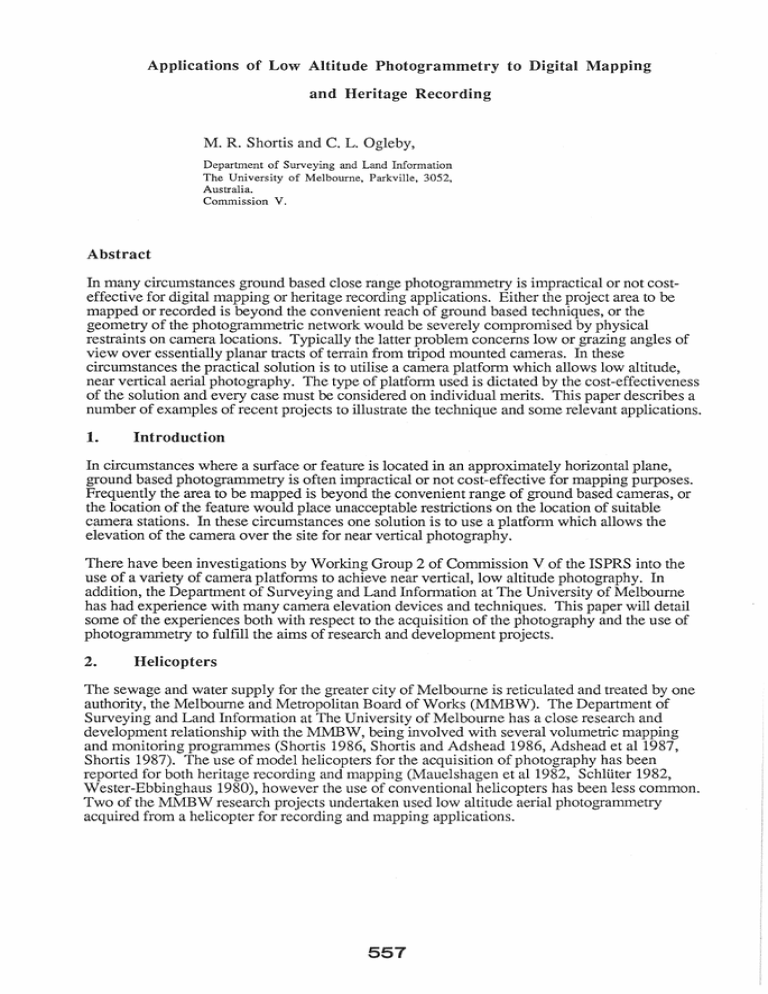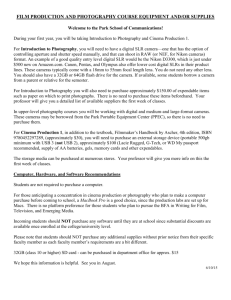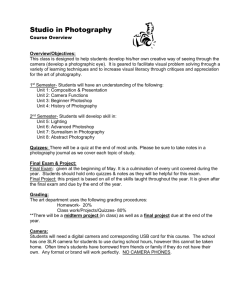Applications of Low Altitude Photogrammetry ... and Heritage Recording
advertisement

Applications of Low Altitude Photogrammetry to Digital Mapping and Heritage Recording M. R. Shortis and C. L. Ogleby, Department of Surveying and Land Information The University of Melbourne, Parkville, 3052, Australia. Commission V. Abstract In many circumstances ground based close range photogrammetry is impractical or not costeffective for digital mapping or heritage recording applications. Either the project area to be mapped or recorded is beyond the convenient reach of ground based techniques, or the geometry of the photogrammetric network would be severely compromised by physical restraints on camera locations. Typically the latter problem concerns low or grazing angles of view over essentially planar tracts of terrain from tripod mounted cameras. In these circumstances the practical solution is to utilise a camera platform which allows low altitude, near vertical aerial photography. The type of platform used is dictated by the cost-effectiveness of the solution and every case must be considered on individual merits. This paper describes a number of examples of recent projects to illustrate the technique and some relevant applications. 1. Introduction In circumstances where a surface or feature is located in an approximately horizontal plane, ground based photogrammetry is often impractical or not cost-effective for mapping purposes. Frequently the area to be mapped is beyond the convenient range of ground based cameras, or the location of the feature would place unacceptable restrictions on the location of suitable camera stations. In these circumstances one solution is to use a platform which allows the elevation of the camera over the site for near vertical photography. There have been investigations by Working Group 2 of Commission V of the ISPRS into the use of a variety of camera platforms to achieve near vertical, low altitude photography. In addition, the Department of Surveying and Land Information at The University of Melbourne has had experience with many camera elevation devices and techniques. This paper will detail some of the experiences both with respect to the acquisition of the photography and the use of photogrammetry to fulfill the aims of research and development projects. 2. Helicopters The sewage and water supply for the greater city of Melbourne is reticulated and treated by one authority, the Melbourne and Metropolitan Board of Works (MMBW). The Department of Surveying and Land Information at The University of Melbourne has a close research and development relationship with the MMBW, being involved with several volumetric mapping and monitoring programmes (Shortis 1986, Shortis and Adshead 1986, Adshead et a11987, Shortis 1987). The use of model helicopters for the acquisition of photography has been reported for both heritage recording and mapping (Mauelshagen et a11982, Schluter 1982, Wester-Ebbinghaus 1980), however the use of conventional helicopters has been less common. Two of the MMBW research projects undertaken used low altitude aerial photogrammetry acquired from a helicopter for recording and mapping applications. 557 2.1 Large Scale Mapping of a Water Distribution Basin Part of the reticulation of the domestic water supply for the metropolis of Melbourne entails piping water from rural catchments into suburban holding basins. Many of these concrete basins are being roofed in an effort to ensure water quality by reducing the likelihood of contamination by airborne pollutants. Prior to this roofmg process, and additionally as part of an on-going monitoring programme, there is a need to map the surface cracking of the structures. It was decided to test the feasibility of using low altitude photography in preference to detailed field surveying, as photogrammetry appeared to offer substantial savings in field time. This is an important consideration as the basin can only be kept empty for a very short time. The aims of the project were to assess the accuracy obtainable from photogrammetry, to determine the whether the cracking and joints could be seen on the aerial photographs and to determine the cost effectiveness of using photogrammetry. The specific task of the survey was to provide plans at a scale of 1:250 showing the berms, cracks and joints with contours at 5 centimetre intervals. One basin that had been emptied for routine maintenance, the Mt. Waverley Distribution Basin, was chosen as the test site (Figure 1). Overlapping pairs of aerial photography were acquired using a Zeiss Jena UMK camera mounted vertically in the floor of a Bell Jetranger 206B3 helicopter. A helicopter was chosen as the camera platform for a variety of reasons. Firstly, a helicopter could obtain approval from the aviation authority for lower operating altitudes than fixed wing aircraft, and secondly the helicopter is capable of the slow forward velocities needed for low altitude aerial photography. The Bell Jetranger is an appropriate choice of because it has a pre-approved modification for a camera port in the left rear floor (Figure 2). The correct selection of a slow forward speed is necessary for two important reasons. The first is the forward motion of the camera whilst the shutter is open. As the UMK is designed as a terrestrial camera the minimum shutter speed is slow, leading to the possibility of significant image blur. The slower the forward motion, the less blur along the line of flight. This phenomenon tends to reinforce linear features which are parallel to the line of flight and smear those features perpendicular to the line of flight. In the case of a surface crack survey, any bias correlated with the crack direction could result in a misleading interpretation and therefore should be minimized. The second reason is the minimization of vibration induced image blur, particularly those associated with solid body rotations during the open shutter period. At very slow forward velocities, that is with the helicopter near a stationary hover, low frequency vibrations become distinctly noticeable to the occupants. At high forward speed all vibration apparently disappears, although high frequency oscillations are present. Based on the experience of the flight operations staff and the performance characteristics of the Jetranger, a forward speed of 40 knots was selected as the best compromise between forward image motion and vibration induced motion. The photographs were taken with a standard 60% overlap at an altitude of 800 feet (243m) above ground level. The photographs were taken one per pass using glass plates as it was not possible at that time to obtain roll film of a suitable width for the UMK. The location of each photograph was pre-computed and the helicopter was visually navigated along the flight-lines. The camera was fired once the helicopter passed over the ground point corresponding with the planned principal point. The plate cassette was then changed manually to be ready for the next pass and the completion of the stereopair. Each stereomodel contained six fully controlled, premarked points. This provided for redundant control in order to strengthen the analytical solution for the models. The points were marked with 0.5m square yellow and black quadran ted targets and coordinated onto the site datum. 558 The plans of surface cracking and jointing (Figure 3), and contours (Figure 4), were produced analytically from Zeiss Jena Stecometer stereocomparator observations to points and detail strings. Spot heights of points were also observed to enable the MMBW to check the elevations provided on the contour plan. It was found that all points were within 15mm of their field surveyed heights (giving 1:15000 accuracy) with only one exception, and this exception was most likely the result of misidentification of the feature. The plans were substantially complete in tenns of coverage, except for the northern edge of the smaller basin which was obscured by deep shadow and some of the floor which was obscured by surface water. Rectified photographs at the same scale of the plans were also provided. At the magnification used for observation and in the large scale enlargements some forward image blur was evident, but the degradation of the negative did not appear to effect the accuracy of observation detrimentally. The consistent magnitude and direction of the image blur indicated that forward motion of the camera was the dominant factor, confrrming the expectation that vibration induced image blur would be minimal. According to the evaluation performed by the MMBW the project successfully showed the potential of the use of large scale, low altitude photogrammetry for mapping concrete structures similar to this holding basin. 2.2 Humes Pipe Factory The MMBW is also responsible for the maintenance of the rivers and their banks in the city. Part of a reserve adjacent to the Maribymong River contains an historical site that is important for a variety of reasons (the most significant being the fact that centrifugally spun concrete pipes were first developed here). The site contained a number of buildings in differing states of repair that were the subject of a major terrestrial photogrammetric survey (both interiors and exteriors). Following the success of the low altitude photogrammetric mapping of the Mt. Waverley basin, it was decided to use similar techniques for mapping the rooflines of the structures. The same helicopter was used for the photograph acquisition, however this time a Hasselblad 500 ELM was mounted externally on the nose of the Jetranger (Figure 5). Again a forward speed of 40 knots was adopted. Although the nose mount appeared less stable than the floor mount position used for the UMK, the advantage of having the operator in the front seat of the helicopter outweighed the potential vibration problem. From this the position the operator is more easily able to check the coverage and exposure interval. Flight-lines were pre-computed and successive runs of photographs were acquired at an altitude of approximately 160m above the site. The reserve is adjacent to a residential area with a higher minimum height restriction than the vacant land under study, so some dramatic helicopter manoeuvres were occasionally necessary to keep within aviation requirements. Minimum field control for each run was pre-marked by O.Sm square, yellow and black quadran ted boards. These were coordinated onto the Australian Map Grid datum. Extra control for each model will be provided where necessary by aero-triangulation and computation through the bundle adjustment program suite in the Department of Surveying and Land Information. The photograph acquisition was very successful in terms of scale and coverage. Unfortunately, the quality of the imagery is poorer than anticipated as it exhibits both forward motion and vibration induced image blur. Future photography would produce better results from a vertical mount for the Hasselblad which could be used over the port in the floor. However the production of 1:500 scale plans would not be severely influenced by the lack of image quality. At this stage the photography has been archived for future use and to date no mapping has been undertaken. 3. Kites The history of kite photography has been detailed by Georgopoulus (1982), but only recently has photogrammetric potential of this type of photography been realised. Kites are a cheap and easily available method of elevating a camera for near vertical photography, and in an appropriate wind can provide a stable camera platform. With the application of analytical 559 procedures camera ""U.",-,LV-'-'-'-~"'-V'J.J. camera systems can now and precisions. resulting from kite borne of predictable accuracies UJ..H,-'-V,U,0-'-V-'--'-U.i ,U,-'--'-'VLUL-'-U.I.-,"-V-'--L photography the site EI Qitar in Syria has use of been published (Ogleby 1986), so a brief summary will be presented here. The kite to acquire the photography was a 'Jalbert Parafoil' self inflating sled which had a high lift in moderate winds and possessed fair degree of stability when airborne. The camera was a standard Olympus OMI0 auto-exposure, motor driven 35mm fitted with a Tokina 28mm lens, without additional fiducal marks or film flattening devices. camera was flown over the main areas of interest, at varying heights, in a flight configuration similar to a run of standard photographs. resulting photographic overlaps were considerably different those usually photogrammetry, both in terms relative scale and ,''"',u" but as the negatives were to be in a stereocomparator the only major the 'pairs' was coverage of the site. '-'-'-A'-"-'-A., ........ measurements to ground distortion characteristics. was later verified camera on a test range. The final precision of location on and O.05m height, which is comparable to three-hair computer generated plan was enhanced and annotated by the official base map of the site architecture (Culican and McClellan this instance enabled a high level of detail to be achieved for 1984). The use of base mapping with a minimum of field and a precision and accuracy comparable of field survey. Simple structures cameras are acquiring photography with a vertical perspective. their low cost and relative portability they are popular with researchers such as botanists and engineers require photography for interpretation only. recent projects have utilized tethered bipods to provide a stable camera platform to acquire photography for quantitative assessment. 4.1 Biomass Monitoring sewage is disposed of by one of two methods. The waste from the eastern half and mechanically piped into the ocean, whilst from the western is pumped to an experimental farm for simultaneous treatment and use as a soil The environmental monitoring branch of the MMBW maintains several intertidal test sites near the sea discharge location in order to measure impact of the ""'~L"""'..",A" on the local environment. This is not only by sampling water but also by of intertidal molluscs on rock platforms. investigations assessing the distribution and of littorinidae molluscs and studying flow patterns across the surface upon which molluscs grow. The increase in size of the shells can be measured the field but it is consuming to measure the population change and exceedingly difficult to survey flow patterns and surface topography between tides. It was decided to use a photogrammetric approach to this for two reasons. Firstly, stereopairs of photographs a the shells and their in1ll1ediate environment (that can be stereomodels can provide details surface rn.-n,rHT1r'·',,",YH trial project was undertaken on several test squares at a site at Boags' Rocks, close to the outfall site. If this photography could provide the marine scientists with the data they required, then all sites would be photographed to give an initial epoch of data. One of the requirements of the project was the supply of contour plans of the surface with a 5mm contour interval. At the time of the project this was more easily provided from the restitution of pairs of metric photographs. Two Wild P32 cameras were available (one belonging to the Department of Surveying and Land Information and the other to the MMBW) so it was decided to use these cameras in a stereometric configuration. A bracket was fabricated to hold the two cameras in a predetermined (but flexible) relationshipbasically a one metre separation with parallel vertical axes. This bracket was suspended under a braced bipod of a design inspired by Fryer (1984). The cameras could be raised and lowered between exposures to enable film to be advanced or glass plates charged. The cameras were suspended so that they would hang vertically about the long axis of the bracket, and were levelled in the other direction by using the crosshairs of a nearby theodolite as a reference. The braced bipod provided a surprisingly stable camera platform. It was constructed from 6" diameter lengths of polycarbonate pipe and was light enough for transport on the roof of a car. Once erected the structure was free standing, but with two expensive survey cameras at stake the bipod was also anchored to the ground with guy ropes (Figure 6), Brass bolts were fired into the rock platform at selected locations to provide a minimum of three fully controlled, pre-marked points per model. The marks were connected to the national coordinate and height datum, which then enabled comparisons to be made between the four monitoring locations. The photography was undertaken at low tide, which unfortunately did not always coincide with optimum lighting conditions. One platform was in fact photographed at midnight under floodlights, which was successful except for the odd occasion where the floodlights reflected off the wet surface and caused image flare. photographs were taken on both black and white glass plates and colour roll film. Interpretation of the marine growth is best undertaken from the colour photography; whilst the glass plates provide dimensionally stable records suitable for archival storage. order to produce the contour maps of the test site, the stereopairs were mounted in a Zeiss Jena Topocart and oriented onto the ground control. Because of the design of the camera bracket all of the tilts of the photographs were within the tolerances of the Topocart. The plotting of the contour plans was very straight forward, except for the depressions filled with water. In these cases the contour interval was·corrected to compensate for the refraction of the light rays. The plans were well received by the marine scientists, who were also impressed by the potential of using the three dimensional images of the rock platforms and molluscs for qualitative assessment and interpretation. The contour information on the plans was to a higher level of detail than that required for the flow analysis intended by the scientists. Once the results had been accepted for the test site the photography was undertaken at the other three locations (a total of 10 test areas), with minor modifications to accord to the initial reactions of end users of the photogrammetric product. 4.2 Mapping Surface Archaeological Features. details of the use of a wooden bipod to elevate a camera over excavated trenches on the archaeological site EI Qitar have also been reported previously (Ogleby 1986), so again only a brief summary will be given here. The excavation technique employed at EI Qitar created a matrix of excavated squares containing architectural features. These architectural remains are an important source of information in the study of the site, so full records are generally made of each feature as it is exposed. The interpretation of these features is greatly enhanced by the use of photography, so a device was constructed to acquire near vertical photography over each excavated square. A wooden bipod (after a design by Fleming, 1978) was constructed from recycled timber in a village close to the archaeological site under investigation. This was used to elevate an Hasselblad SOOELM camera over each of the Sm square trenches, and also to move the camera between exposures to 1 acquire stereo coverage. Initially the photography was to be used for interpretation purposes only, however it became necessary to attempt to use these records for mapping. Plans of the wall footings visible in Building 10 (Figure 7)were prepared from the direct plotting of the negatives in a Topocart stereoplotter. The photographs were treated as metric, and a conventional relative and absolute orientation was performed by the machine operator. The control was minimal for each model, which made any detailed analysis of the quality of orientation difficult (however this was not considered necessary). In this instance the planimetric detail was important, and no attempt was made to plot contours. As a result of this, the plans were to an accuracy equivalent to that possible using conventional field survey, and to a higher level of detail. The increased information content was considered an improvement over the existing mapping technique used by the archaeologist. The archaeologist was also aware that had the photographs been taken without an overlap then there would have been no record of the building resulting from that season of excavation. 5. Other Camera Platforms Various other devices have been used from time to time to hold metric and non-metric cameras in a near vertical orientation. Few of these are of a level of technology that requires separate discussion, but some are worthy of passing mention. The devices and structures include aluminium frames (built specifically to hold stereometric cameras 1m from a horizontal test surface), painter's ladder and scaffolding (erected over mosaic tile,d floors) and 'cherry pickers' and other powered hoists. If a recording or mapping task requires near vertical photography, then with a little inventiveness some method of elevating a camera can usually be found. The main drawback for many of these platforms is that some visual pollution of the image is caused by the intrusion of the camera support structures. 6. Conclusion This paper has described a number of projects which have have all had a common theme of low altitude near vertical photography for photogrammetric mapping or recording. In the context of this paper low altitude can be very low indeed, and at the other end of the scale the altitude can be approaching that of conventional aerial mapping photography. However in all cases the techniques could be described as at least non-conventional, if not intrinsically novel. Although the advent of forward motion compensation in standard aerial mapping cameras is likely to decrease the range of altitudes to which non-conventional applications might apply, the range is unlikely ever to disappear entirely. Recording or mapping of the natural or artificial features on the surface of the Earth at very large scales will always be a demand placed on photogrammetry to which only innovative techniques can respond. References CULl CAN, W. and McCLELLAN, 1984, Abr Nahrain, Volume ... """',,....-"'7' 1983-84, pp 29-63. FLEMING, D. 1978, 'A Simple Wooden Bipod for Vertical Archaeology, Bulletin 15, 1978, U t"lr'>1"r..rrT'''T\t''I'<'' FRYER, J.G. 1984. Photographic Survey of a Vol 32(2). pp 99-106 MAUELSHAGEN - Kalibrierung in der P hotogrammetry and Remote Sensing, Ranges" of 1982. pp 319-326 Archaeometry.' Ottawa 1896. OGLEBY, C. L. 1986 'Applications Non-metric International Archives of Photogrammetry, pp 102-111. SCHLUTER, D. 1982 'Ferngesteuerte Kleinflugzeuge und Speziell Kleinhubschrauber flir Nahbereichs-Luftaufnahmen'. International Archives of Photogrammetry and Remote Sensing, Volume 24 Part V/2, York 1982. pp 433-442 SHORTIS, M.R. 1986. Close Photogrammetric for Structural Monitoring, Engineering Surveillance. Australian Journal of Geodesy, Deformation Surveys Photogrammetry and Surveying. Vol 45: pp SHORTIS, M.R. and 1986 Pumping Station Project. Proceedings, 6th Melbourne, 1986. 9p <'Tr/"lFl'''' to the MMBW Sewage Cartographic Conference. SHORTIS, M.R. 1987. Precise Monitoring of Large Engineering Structures Using Close Range Photogrammetry. Proceedings, Symposium on the Application of Close Range Photogrammetry. Department of Surveying and Land Information, University of Melbourne, 1987. 16p SHORTIS, M.R. and ADSHEAD, Pumping Station Melbourne, 1986. 9p WESTER-EBBINGHAUS, W. 1980. Helicopter. P hotogrammetric to the MMBW Sewage Cartographic Conference. Controlled Model Figure 1. Aerial view of the Mt. Waverley Distribution Basin Figure 2. 564 Detail of the Camera Port and UMK Camera in the Floor of the Bell Jetranger Helicopter (left) I F- - II I----- 1- I·f--- ~ I-- ----1-- I'I ,..L- c - - I r--, ===r-7 1111 I- I~V ~>- I 11 I 1 ~ ,- I f I I I :x:r=--- \ I I I ~ -t-- I V II J I I MT WAVERLY DISTRIBUTION REa Dept. of Surveying. - III I I I 'I 11,'1 I .-:;t:::: - Ir,~ 1- .'-.: I-- '[ I - - If t-- I--I'r ~ ~~ ~ ~ ..... Scale 1 1250 University of Melbourne Figure 3. Surface Cracking and Jointing in the Mt Waverley Distribution Basin MT WAVERLY DISTRIBUTION RES. Dept. of Surveying, University of Melbourne contour Interval .05 Scale 1 1250 Figure 4. Contours of the Floor of the Distribution Basin 565 Figure 5. The Nose Mount for the Hasselblad Camera on the Helicopter o .3 41 IIIUtLDING 19ure 6. A View of the Polycarbonate Pipe 'Bipod' Figure 7. cameras in Use With Two Wild 10 ~ The Published Plan of Building 10, EI Qitar





